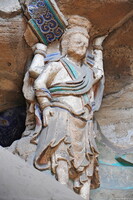Yungang Grottoes: Cave 13
unknown (Chinese)

Download1A2-CH-D-YG-13-A17_cp.jpg (527.1Kb)
Alternative Title
云冈石窟
Date
471-494Description
Detail, four-armed Vajra figure supports the arm of Maitreya Buddha; The Yungang Grottoes are located 16 km west of Datong and comprise about 53 caves and 51,000 statues. The site stretches about 1 kilometer from east to west and was hollowed from the sandstone cliffs of the Wuzhou Mountains during the 5th century CE under the patronage of the Northern Wei dynasty. Founded by the Tuoba or Toba people, who ruled northern China during the Northern and Southern Dynasties period (310-589 CE), the Wei dynasty adopted Buddhism as its state religion. Work was begun at Yungang by the emperor Wenchengdi (reigned 452-465). The caves range in width from 23 m to a few metres. In 494, the Wei moved their capital from Datong to Luoyang and the Yungang Grottoes slowly fell into decay. The Grottoes have been a UNESCO World Heritage site since 2001. Caves 11, 12, and probably 13 were constructed under the supervision and support of the imperial court. Source: Grove Art Online; http://www.oxfordartonline.com/ (accessed 5/9/2011)
Type of Work
relief (sculpture); sculpture (visual work); shrine (structure)Subject
architecture, decorative arts, deities, Buddhism and art--China, Silk Road, Buddhist cave art, Chinese, Northern Wei
Rights
Rights Statement
Licensed for educational and research use by the MIT community only